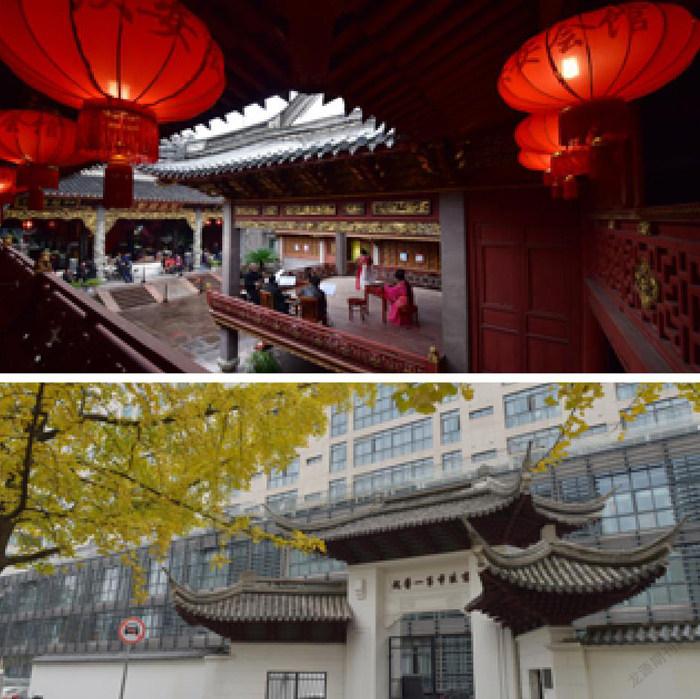宋韵流芳曙色新
赵淑萍


宋代,尤其是南宋,宁波从海疆辟地成为京畿藩篱,海曙作为宁波子城、罗城的所在地,历史文化遗存俯拾皆是。巍巍鼓楼、灿然月湖、繁盛江厦街、典雅天妃宫……更有各种碑、塔、寺、桥、坝星罗棋布。海曙,流淌着浓浓的宋韵,书香氤氲,风致绰约。
城纪千年 人文其昌
历史上的鼓楼,既是内城子城的南城门,又是外城罗城的中心。它曾经被称为谯楼、望海军门(楼)、奉国军门(楼)。
宋庆历八年(1048年),太守王周重修奉国军楼,新上任的鄞县县令王安石,特为奉国军楼的刻漏作了一篇《新刻漏铭》。刻漏是中国古代汉族科学家发明的计时器。年轻的王安石在鄞县浚治东钱湖,踏勘广德湖,率领民众筑海塘,置碶闸,推行“青苗法”等一系列改革措施。他后来的变法,很多就是依据了“鄞县经验”。他在铭文中写道:“其政谓何,弗棘弗迟。”这位杰出的政治家、改革家、文学家在鼓楼上意气风发,他是以刻漏那样“弗棘弗迟”的速度和精神自勉,要求自己勤政、严谨、恭虔。
在宁波市第一医院靠县学街一侧,有一个古色古香的老门楼,它就是鄞县孔庙仅存于世的“棂星门”。王安石来鄞县时,鄞县没有县学,而邻县慈溪早就创立。他把县治附近的一所唐代建造的孔庙作为学校,建起了鄞县的第一所官学。他多次写信聘请“庆历五先生”等人任教,创立县学后,鄞县的学风明显好转。此前,鄞县进士数量不到20人,而在王安石办学后人数大增,尤其是南宋,达到601人。王安石治鄞千日,影响却是千年。
宋高宗时,鼓楼又改称为“奉国军楼神祠”。宋高宗赵构还是小康王时,南渡到明州,留下了一路的故事。传说他被金兵追逐,逃到了鼓楼。云中出现唐时平“安史之乱”的五位将军张巡、许远、南霁云、姚訚、雷万春,他们挥舞大旗来救小康王。金兵追至楼下,只见蛛网密布,一片荒凉,以为无人进入,遂往他途。由此脱逃的赵构登基后下诏追封鼓楼为“奉国军楼神祠”,并在祠中塑了五位将军的像。在海曙,高桥黄泥墙村还流传有村姑救康王的故事。
沧海桑田,风起云涌,官府和民间历次修缮明州城。两宋时期,修缮的人中就有大名鼎鼎的唐宋八大家之一的曾巩,还有状元丞相吴潜。
一湖居中 书香揽胜
“三江六塘河,一湖居城中”。这湖,就是月湖。
月湖,被誉为景观之湖、水利之湖、书香文化之湖。月湖开凿于唐代,到了宋代,已经成为宁波城中生产与生活的命脉。当时,湖上龙舟箫鼓,湖边车水马龙,达官贵人、贩夫走卒往来不绝。宋嘉祐年间,钱公辅任明州郡守,对月湖作了大规模整修,用泥沙堆积成偃月堤,并取孟子“独乐不若众乐”之意,在月湖建造了众乐亭,周围遍植花木。亭子落成,钱公辅欣然提笔,写下迄今可见的第一篇吟诵月湖之诗:“谁把江湖付此翁?江湖更在广城中。葺成世界三千景,占得鹏天九万风。宴豆四时喧画鼓,游人两岸跨长虹。它年若数东南胜,须作蓬丘第一宫。”甚至,他在离开宁波后,还邀请许多文人官员为众乐亭和诗,王安石、司马光、曾巩等纷紛唱和,开创了月湖吟咏的一代文风。数年后,郡守刘珵再一次浚治,湖上之景为之一新。刘珵以景物特色一一为之取名:花屿,芳草洲,柳汀,竹屿,烟屿,芙蓉洲,菊花洲,月岛,雪汀,松岛。十景既成,刘珵诗兴大发,唱《咏西湖十洲》,舒亶、陈瓘等欣然唱和。于是,月湖又一次迎来赋咏盛事。
到了南宋,“城中月湖半归史”。史氏,本是寒门庶族,通过科举,最后成为钟鸣鼎食的簪缨世家,书写了“一门三宰相,四世两封王”“五尚书,七十二进士”的传奇。史家的发迹对南宋的政治格局和宁波的地方文化都产生了莫大的影响。史氏家族第一位丞相史浩告老还乡时,建府第于月湖菊花洲,后称越王府。又在菊花洲建宸奎阁,藏两朝皇帝题字、诏书。在月岛建花果园庙。朝廷又将月湖竹洲赏赐给他,筑“真隐馆”。馆内垒石为山,引泉为池,模仿四明山峰的景致。孝宗亲笔御书“四明洞天”相赠。史浩极重儒学,他割竹洲之宅,请沈焕、沈炳、吕祖俭设堂讲学,后人称“竹洲三先生”。又请陆学重要人物杨简到家中讲授,其子史弥远受其教。在史氏倡导下,著名的“淳熙四先生”在月湖各开讲院,月湖成了陆学的中心。史浩长孙史守之,官至朝奉大夫。由于不满叔叔史弥远专权朝政,辞官回里,数诏不赴。先住在祖父构筑的竹洲上读书赋诗,后在芳草洲上建藏书阁,与月湖之南的楼钥藏书楼并称“南楼北史”。宋宁宗闻史守之事迹,赐御书“碧沚”。
两宋之时,月湖两岸人文荟萃,显宦名流宅第星布,书院、藏书楼次第矗起,诗社雅集,弦歌不绝。“里为冠盖,门成邹鲁”,明州之学术、文学皆荟萃于月湖。
海丝圣地 千帆竞发
宁波三江口的甬江东岸,矗立着一座精美的建筑——天后宫,又称庆安会馆。它是全国重点文保单位,又作为中国大运河(宁波段)的重要遗产而成为世界文化遗产点。
北宋淳化三年(992年),明州城继唐代之后又设市舶司,这是专门管理外贸兼外事的机构。明州与泉州、广州成为全国三大外贸口岸。今天宁波三江口江厦公园的水岸,宋代时是国内外贸易的码头区。江上帆樯如林,岸上货物拥挤。为了方便外贸,就在罗城开了一座市舶司专用的城门,直通城内的市舶司衙署,百姓称为“市舶门”。门外建来远亭,为市舶司稽查人员的现场办公点。从唐中晚期到北宋,波斯、阿拉伯商人、高丽来使、留学生云集明州,其中不少人长期居住城中。
北宋宣和五年(1123年),给事中路允迪一行乘明州打造的两艘“神舟”和六艘“客舟”,从明州港出发奉使高丽,归国时突遇狂风巨浪。危急中众人仰天向妈祖求祷,五昼夜后终于平安抵达明州。事闻于朝,宋徽宗下诏封妈祖为“顺济夫人”,赐庙额为“顺济”。这是妈祖第一次受到皇帝册封。
南宋绍熙年间,福建莆田船主沈法询在宁波经商,一次在南海遇险,因祈求妈祖而化险为夷。回到宁波后,他捐出自己位于东渡路的住宅,建造了一座妈祖庙。庙中的妈祖神像,是从莆田湄洲祖庙分炉而来。这是宁波第一座妈祖庙,也是浙东地区第一座妈祖庙,后称“天妃宫”“天后宫”。宁波又成为最早接纳和传承妈祖信仰的重要地区之一。
南宋,明州一度成為江浙对高丽、日本等国官方往来以及通商贸易的唯一合法港口。
宋韵文化是浙江打造文化高地的金名片。而海曙的宋韵文化因其独特的地理人文而极有辨识度。在唱好杭州、宁波历史文化双城记中,愿千年海曙再谱新章。
In the Song dynasty (960-1279), especially the Southern Song dynasty (1127-1279), Ningbo turned from a frontier city bordering the sea into a city sitting right next to the capital city Lin’an (present-day Hangzhou). In Haishu district, one of the central districts in Ningbo, unsurprisingly, historical and cultural relics can be found everywhere. The towering Drum Tower, the tranquil Moon Lake, the prosperous Jiangxia Street, the elegant Tianfei (Heavenly Mother) Palace, not to mention the numerous steles, pagodas, temples, bridges and dams. The district is filled with the Song dynasty culture.
Historically, Ningbo’s Drum Tower not only served as the south gate of its inner city, but also as the center of its outer city. It was alternatively called the Qiao Tower, the Wanghaijun Gate (Tower), the Fengguojun Gate (Tower).
In 1048, when the prefect of Mingzhou (present-day Ningbo) rebuilt the Fengguojun Tower, Wang Anshi (1021-1086), who was just sworn in as the magistrate of Yin county (present-day Yinzhou district in Ningbo city), dedicated a piece specially for the tower’s ke lou, a traditional Chinese water clock.
In the “Epigraph on the New Ke Lou”, he wrote, “dealing with government affairs should be like the ke lou, neither too fast nor too slow.” During his tenure in Yin county, Wang led the local people in dredging the Dongqian Lake and building seawalls, and introduced a raft of reform measures, foreshadowing the New Policies that he would push through throughout the entire Song territory later.
During the reign of Emperor Gaozong of Song (r. 1129-1162), the Drum Tower was also called “Shrine of Fengguojun Tower". Legend has it that when Gaozong was still a prince, he was chased by the Jurchen troops when in Mingzhou. When he hid himself into the Drum Tower, five generals who had quelled the An Lushan Rebellion (755-763) appeared in the clouds and made the tower look as if no one had been there for years. After Gaozong’s narrow escape, he made the tower a shrine for the five generals.
In Ningbo First Hospital, on the side of the Xianxue (literally “county academy”) Street, there is an old, ancient gate, the Lingxing Gate, the only remaining structure of the Confucius Temple in Yin county. When Wang Anshi came to Yin county, there had been not a county academy established, whereas the neighboring Cixi county had long set up one. He turned the Confucius Temple built in the Tang dynasty (618-907) near the county government into an academy, the first official one in the county. The number of people in Yin county who obtained the jinshi title, the highest degree in China’s imperial examinations, increased significantly afterwards, from a total of no more than 20 to 601 during the Southern Song period.
Another place that was at the center of life in the area was the Moon Lake. Built in the Tang dynasty, the lake became the lifeline of the city of Ningbo in the Song dynasty. At that time, dragon boats sailed on the lake with flutes, drums and music playing, the lakeside was packed with carriages and pedestrians, officials, prominent figures, merchants and the like mixing with each other. In the Southern Song, “half of the Moon Lake belongs to the Shi family”. A humble family originally, the Shis made their mark through excelling the imperial examinations. In all, the family produced “three chancellors, two dukes, five ministers and 72 jinshi”, great influencing the political structure of the Southern Song and Ningbo’s local culture.
At the time, the area surrounding the lake was teemed with mansions belonging to officials and celebrities; many academies and libraries sat next to each other; and poetry societies, literary gatherings and music appreciation meetings were commonplace. It was no exaggeration to say that the best of Mingzhou’s academic and literary minds was concentrated around the Moon Lake.
Then there is also the beautiful Tianfei Palace on the east bank of the Yongjiang River, dedicated to Mazu, the Chinese sea goddess. It is now a world heritage item along the Grand Canal (Ningbo section). In 992, a Maritime Trade Bureau was established in Mingzhou to handle foreign trade and foreign affairs. In fact, the waterfront of Jiangxia Park that we see today used to be the dock area in the Song dynasty for domestic and foreign trade. In the Southern Song dynasty, Mingzhou was at one time the only legal port of official exchanges and trade between the areas of Jiangsu and Zhejiang and Korea, Japan and other countries.

